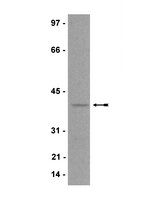A fluorescently tagged C-terminal fragment of p47phox detects NADPH oxidase dynamics during phagocytosis.
Li, XJ; Tian, W; Stull, ND; Grinstein, S; Atkinson, S; Dinauer, MC
Molecular biology of the cell
20
1520-32
2009
Mostrar Resumo
The assembly of cytosolic p47(phox) and p67(phox) with flavocytochrome b(558) at the membrane is crucial for activating the leukocyte NADPH oxidase that generates superoxide for microbial killing. p47(phox) and p67(phox) are linked via a high-affinity, tail-to-tail interaction involving a proline-rich region (PRR) and a C-terminal SH3 domain (SH3b), respectively, in their C-termini. This interaction mediates p67(phox) translocation in neutrophils, but is not required for oxidase activity in model systems. Here we examined phagocytosis-induced NADPH oxidase assembly, showing the sequential recruitment of YFP-tagged p67(phox) to the phagosomal cup, and, after phagosome internalization, a probe for PI(3)P followed by a YFP-tagged fragment derived from the p47(phox) PRR. This fragment was recruited in a flavocytochrome b(558)-dependent, p67(phox)-specific, and PI(3)P-independent manner. These findings indicate that p47PRR fragment probes the status of the p67(phox) SH3b domain and suggest that the p47(phox)/p67(phox) tail-to-tail interaction is disrupted after oxidase assembly such that the p67(phox)-SH3b domain becomes accessible. Superoxide generation was sustained within phagosomes, indicating that this change does not correlate with loss of enzyme activity. This study defines a sequence of events during phagocytosis-induced NADPH oxidase assembly and provides experimental evidence that intermolecular interactions within this complex are dynamic and modulated after assembly on phagosomes. Texto completo do artigo | 19129478
 |
Regulation of renal epithelial tight junctions by the von Hippel-Lindau tumor suppressor gene involves occludin and claudin 1 and is independent of E-cadherin.
Harten SK, Shukla D, Barod R, Hergovich A, Balda MS, Matter K, Esteban MA, Maxwell PH.
Molecular biology of the cell
20
1089-101
2001
Mostrar Resumo
Epithelial-to-mesenchymal transitions (EMT) are important in renal development, fibrosis, and cancer. Loss of function of the tumor suppressor VHL leads to many features of EMT, and it has been hypothesized that the pivotal mediator is down-regulation of the adherens junction (AJ) protein E-cadherin. Here we show that VHL loss-of-function also has striking effects on the expression of the tight junction (TJ) components occludin and claudin 1 in vitro in VHL-defective clear cell renal cell carcinoma (CCRCC) cells and in vivo in VHL-defective sporadic CCRCCs (compared with normal kidney). Occludin is also down-regulated in premalignant foci in kidneys from patients with germline VHL mutations, consistent with a contribution to CCRCC initiation. Reexpression of E-cadherin was sufficient to restore AJ but not TJ assembly, indicating that the TJ defect is independent of E-cadherin down-regulation. Additional experiments show that activation of hypoxia inducible factor (HIF) contributes to both TJ and AJ abnormalities, thus the VHL/HIF pathway contributes to multiple aspects of the EMT phenotype that are not interdependent. Despite the independent nature of the defects, we show that treatment with the histone deacetylase inhibitor sodium butyrate, which suppresses HIF activation, provides a method for reversing EMT in the context of VHL inactivation. Texto completo do artigo | 19073886
 |
p40phox, a third cytosolic component of the activation complex of the NADPH oxidase to contain src homology 3 domains.
Wientjes, F B, et al.
Biochem. J., 296 ( Pt 3): 557-61 (1993)
1993
Mostrar Resumo
The NADPH oxidase generates superoxide in phagocytic cells. It is important for immunity and its deficiency leads to chronic granulomatous disease (CGD). It consists of a membrane-bound flavocytochrome b that lies dormant until activated by the translocation to the plasma membrane of cytosolic proteins, p47phox (phox for phagocyte oxidase), p67phox and p21rac, a small GTP-binding protein. We show here that a novel component, p40phox, forms an activation complex with p47phox and p67phox with which it translocates to the membrane to associate with the flavocytochrome b. cDNA cloning and amino acid analysis revealed that p40phox has an src homology 3 (SH3) domain and a large region of sequence similarity with the N-terminus of p47phox. The primary association of p40phox appears to be with p67phox, and it is present in reduced amounts in patients with CGD lacking p67phox. | 8280052
 |












